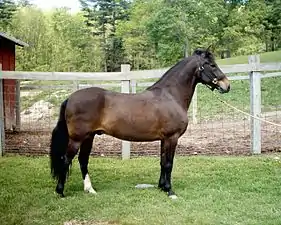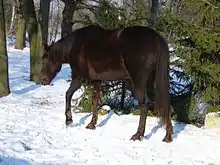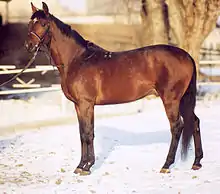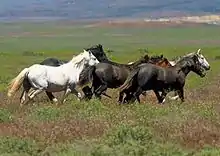Seal brown (horse)
Seal brown is a hair coat color of horses characterized by a near-black body color; with black points, the mane, tail and legs; but also reddish or tan areas around the eyes, muzzle, behind the elbow and in front of the stifle. The term is not to be confused with "brown", which is used by some breed registries to refer to either a seal brown horse or to a dark bay without the additional characteristics of seal brown genetics.
| Seal Brown | |
|---|---|
 A seal brown gelding | |
| Variants | Dark bay, brown |
| Genotype | |
| Base color | Black (E) |
| Modifying genes | agouti gene (A), hypothesized but unmapped qualifier At |
| Description | dark brown body coat with black point coloration and tan coloration around muzzle, eyes, flanks and other "soft" areas. Lacks reddish tint seen in most bay horses |
| Phenotype | |
| Body | dark brown with lighter tan coloration at soft points of body |
| Head and Legs | Black |
| Mane and tail | Black |
| Skin | Black |
| Eyes | Brown |
| Other notes | Not to be confused with pangare |
Like bay, the seal brown color is produced by the Agouti ("A") gene acting upon a genetically black base coat, suppressing the black into point coloration and allowing the underlying reddish or brownish color to appear. However some researchers distinguish seal brown with the qualifier At The genetic study of seal brown is relatively new. Several theories were advanced in the last century to explain the heredity of the seal brown coat, and while a DNA test said to detect the seal brown (At) allele was developed, the test was never subjected to peer review and due to unreliable results was subsequently pulled from the market.[1][2]
The genetically and visually related dark bay coat color, which also features black points and a dark body, differs from seal brown by the absence of tan markings. Another mimic is the liver chestnut, an all-over dark brown coat including mane and tail, that is sometimes confused with seal brown. However, true seal browns have black points characteristic of all bay horses, while liver chestnuts do not.
Identification

The research behind the classification of seal brown as distinct from dark bay is quite new, and as a result, opinions vary on what constitutes a true seal brown. In Equine Color Genetics, Dan Phillip Sponenberg wrote "In general, all dark colors with black points that are lighter than black but darker than bay are called brown."[3] In this text, he classifies black-pointed, clear reddish coats of any shade as bay, and black-pointed coats of any shade with black countershading as brown.[4] These definitions, while precise, are no longer accurate in light of current research.
Seal brown is best described as a black or nearly-black coat with reddish or tan hairs on the "soft parts": the muzzle, eyes, inner ears, underbelly, behind the elbow, and in front of the stifle.[5][6][7][8] Like other coat colors, seal browns can range in shade. The very darkest are just about black except for their tan areas. Lighter examples are easily confused with dark bays. The mane, tail, and legs are always black.[5]
Terminology
Non-horse people often refer to many horse coat colors as "brown," in particular the bay color. Among horse aficionados, a common assessment is that "...[the term] is only used by people with one horse or with two hundred."[3] The implication is that lay observers will refer to a horse's coat color to be "brown" due to a lack of vocabulary, and those discussing large populations of horses will use "brown" out of a need for a more specific vocabulary. The term "seal brown" is unlikely to be part of a novice's repertoire and is therefore preferable when discussing this specific coat color. This coat color is, illuminatingly, called "black and tan" in some languages.[6]

"Brown" but not seal brown
In the most simple terms, the vast majority of horses are indeed some shade of brown, but not "seal brown." Such coat colors include:
- Chestnut, entirely copper-red to liver-brown, without true black hair.
- Bay, reddish-brown to quite dark-brown body coat with true black mane, tail, and legs; dark bays are hard to distinguish from seal browns by even experienced eyes.
- Both bay and chestnut may be darkened by the sooty gene.
- Buckskin, tan or gold body coat with the black areas of a bay (above).
- Dun, commonly tan (though rust or slate-like shades exist) with evident primitive markings.
- Silver dapples, sometimes called "chocolate", are often found in brownish shades.
Seal browns on paper
Not all breed registries or studbooks recognize seal brown as a distinct coat color. The American Quarter Horse Association and American Paint Horse Association both recognize "brown" as a separate category, while the Arabian Horse Association labels all non-black, black-pointed shades "bay."[9][10][11]
Still other registries, such as The Jockey Club which registers Thoroughbreds and Appaloosa Horse Club, offer the designation "dark bay or brown" to cope with the ambiguity in terminology and identification.[7] Among historically German breeds and registries, the term rappe indicates a black horse, braun is bay, while dunkelbraun indicates dark bay and schwarzbraun indicates seal brown (literally black-brown).[12] In France, seal brown horses are recognized among the "black coat family".[13]
Related coat colors
The presence of other coat color genes can modify a seal brown coat. The seal brown family includes:
- Brown Buckskin, is a result of the dilution effect of a single copy of the cream gene. Sometimes called smoky brown. The black areas of the seal brown coat are unaffected or slightly lightened, while the reddish areas are more golden. These should not be confused with traditional buckskins.[14]
- Sable champagne, a result of the dilution effect of the champagne gene. Like all champagnes, sable champagnes have hazel eyes and pinkish, freckled skin. The coat is a flat, diluted grayish- or purplish-brown, somewhere between the warm pumpkin tones of the bay-based amber champagne, and the cool purplish tones of the black-based classic champagne.[15]
- Brown dun, a result of the dilution effect of the dun gene. Like all duns, brown duns have conspicuous primitive markings including at least a dorsal stripe and darker points. The primitive markings of brown duns are black, and the coat color is somewhere between the slate gray of a grulla and the tan of a bay dun.[16]
Genetics of seal brown
The appearance of a horse's skin, eye, and coat-color is determined by pigment chemicals called melanins. Two types of melanins are used by mammals, such as horses and humans: eumelanin, which is visually black to brown, and phaeomelanin, visually red to yellow. Specialized cells in the skin and eyes, melanocytes or pigment cells, produce melanins and deposit them into the skin and hair using complex chemical reactions. The instructions for these chemical reactions are genetically encoded as DNA, and are therefore inherited. To be seal brown, a horse must have at least one copy of the functional MC1R gene (E/E or E/Ee) and must have one of the following genotypes at the Agouti locus: A/A or A/a.
One protein with an important role in eumelanin production is Melanocortin 1 receptor (MC1R). The gene which encodes a functional MC1R protein occupies the Extension locus, or chromosomal position, and is symbolized by the capital E. A mutation, or change, in the equine MC1R gene, that resulted in a non-functioning MC1R protein, was identified in 1996.[17] This form of the gene is symbolized by the lowercase e or sometimes Ee. Since each horse has two copies of the MC1R gene, one from each parent, horses with one "broken" copy (e) can still produce eumelanin in the hair. However, if a horse has two copies of the "broken" allele and therefore no copies of the functional E allele, the horse is completely incapable of depositing black pigment in the hair. Such horses are chestnut, or at least, are not black, bay, or seal brown.
The gene with the greatest role in the seal brown coat phenotype is Agouti signalling peptide (ASIP) or simply Agouti. The functional Agouti signalling peptide (protein) acts as a switch between red-yellow phaeomelanin and black-brown eumelanin. It is ASIP that is responsible for the alternate banding of dark and light on animal hair, although it is also responsible for whole-body effects. ASIP attaches to MC1R molecules to temporarily prevent the latter from continuing the production of eumelanin, and so phaeomelanin is produced in its stead. An individual horse can only have two copies of the Agouti gene, with the following known alleles or options:[5]
- a (mutation, recessive) uniformly black coat.
- A (mutation, 2o dominant) black restricted to black points, responsible for standard bay.
Theories of the existence of additional alleles on the Agouti locus have been proposed, but have not been verified. These are [5][18]
- At (mutation, 3o dominant) poorly restricted black points, responsible for seal brown.
- A+ (wildtype, dominant) highly restricted black points.
The A and At alleles cannot be distinguished by DNA testing. A test had been developed, but the underlying studies were not peer-reviewed and the test was pulled from the market due to inconsistent results[1] Genetic tests exist only for two forms, dominant A and recessive a.[19] The genetic causes of seal brown and wild bay are still thought to be at Agouti.[20]
Former theories about the genetics of seal brown
An early version of the currently-accepted equine Agouti gene theory was first presented in 1951 by Miguel Odriozola in A los colores del caballo, subsequently reviewed by William Ernest Castle in Genetics.[21] This theory prevailed until the 1990s, when discoveries of similar conditions in other species provided alternate explanations.
Black and pangaré
For a period, the seal brown phenotype - black or near-black coat with tan or red hairs on the soft areas - was described as a true black coat affected by pangaré, or mealy-factor.[22] Pangaré is a quality common to the Przewalski's horse and so-called primitive horse breeds such as the Exmoor Pony. The trait is characterized by pale hairs, typically off-white to light tan, around the eyes, muzzle, and underside of the body.[23]

This theory was discarded when the equine Agouti gene (ASIP) was sequenced in 2001, finding all horses fitting the seal brown phenotype did not possess the homozygous recessive a/a Agouti genotype.[24]
Tyrosinase-brown
Tyrosinase-related protein 1 (TYRP1) is a protein involved in melanin synthesis, and is encoded by the TYRP1 gene, also called the brown (b) locus. In humans, mutations in the TYRP1 gene account for variations in "normal" skin, hair and eye coloration, as well as types of clinical Albinism. Mutations in the TYRP1 gene of other mammals result in various reddish-brown coat color phenotypes: Brown in mice, Chocolate in cats, Chocolate in dogs, and Dun in cattle.[25]
The phenotypes associated with TYRP1 mutations are typically rufous or chocolate rather than the black-dominated coats of seal brown horses, and usually result in pinkish-brown skin and light eyes. This is not the case for seal brown horses, and the role of TYRP1 in seal brown was ruled out after it was sequenced in 2001.[24]
Extension-brown and dominant black
The allure of a pure black coat on a horse has struck horse breeders for centuries, resulting in all-black breeds like the Friesian horse. The breeding of pure black horses is attended by two problems: some black coats fade with exposure to light and sweat, and breeding two "black" horses together would sometimes produce non-black horses. In some cases, faded true black horses have lighter coats than the darkest near-black horses.[5]

To account for this, W.E. Castle postulated that there was a third allele at the Extension locus: ED or "dominant black". Based on the existence of such conditions in other animals, Castle suggested that the dominant black gene (ED) would override the "points" pattern of dominant Agouti (A) and produce black or near-black horses, which could then go on to have bay offspring. The implication was that the seal brown coat color, which is often quite nearly black, could be produced by this allele.[26]
Similarly, Sponenberg once hypothesized an Extension-brown (EB) allele, dominant over the wildtype E. He described an allele responsible for black countershading, or sootiness, which would distinguish all shades of brown from all shades of bay.
Both theories were laid to rest after the characterization of the equine MC1R or Extension, which showed no such alleles.[24] However, it remains likely that a genetic control for sootiness does exist.
Dark bay vs. seal brown
Both Dark Bay horses, which have a black mane, tail, and legs with a dark reddish brown or sooty coat, and seal brown horses, which have very dark brown coats in addition to black "points", with reddish or tan hairs around their muzzle, eyes, elbows, and flanks have one of two genotypes at the Agouti locus: A/A or A/a.[19] Both coat colors exhibit a broad range of potential shades due to a variety of factors including the bleaching or fading of black hair, nutrition, and the presence of sooty or countershading factors.
Many black horses fade, sunbleach, or otherwise undergo a lightening of their coat color with exposure to sunlight and sweat. These horses are often mistaken for seal browns or dark bays. Horses which do not undergo such fading are now usually called “non-fading” black, though other terms were used in the past.[27] However, though hypothesized, there does not appear to be a separate “non-fading” allele for black, either.[19] Mineral and vitamin deficiencies can also contribute to a lighter coat, similar to sunbleaching.

Black-pointed horses that are not uniformly black often exhibit a trait called sootiness. A sooty coat exhibits a mixing of black or darker hairs more concentrated on the dorsal aspect (top) of the animal, and less prevalent on the underparts. Sootiness is thought to be a form of countershading. Horses without any sootiness are termed "clear-coated". Sootiness can be minor or quite extensive, and often includes dappling. Dark bay horses are typically sooty. The difference between the top-down distribution of the sooty trait and the lighter soft areas of a seal brown can also be difficult to distinguish from one another. The team of French researchers who developed the DNA test for the recessive a allele also discussed the possibility that Extension might be dosage-dependent. They found a statistically significant tendency for lighter bays to be heterozygous for the dominant, wildtype Extension allele (E/e, also written E+/Ee) while darker bays were more often homozygous (E/E). The authors acknowledged that other factors could play a role, and that the claim needed to be studied on a greater scale.[28] This type of dosage-dependent behavior was not observed with Agouti.[29]
References
- http://colorgenetics.info/equine/enigmatic-brown-horse
- http://www.petdnaservicesaz.com/equine-testing/understanding-equine-dna-and-agouti/
- Sponenberg, Dan Phillip (2003). Equine Color Genetics (2 ed.). Blackwell. ISBN 0-8138-0759-X.
- Sponenberg 2003. pg 25. "As a general rule, better accuracy is achieved by distinguishing brown from bay by the presence of sooty countershading."
- Evans, James Warren; Warren J. Evans; Anthony Borton (1990). The Horse (2 ed.). Macmillan. ISBN 0-7167-1811-1.
- B. Kostelnik. "Brown". The Horse Colors Site. Hippo-Logistics. Archived from the original on 2009-04-23.
- "Color Guide". The American Stud Book Principal Rules and Requirements. The Jockey Club. Retrieved 2009-03-01.
Dark Bay/Brown: The entire coat of the horse will vary from a brown, with areas of tan on the shoulders, head and flanks, to a dark brown, with tan areas seen only in the flanks and/or muzzle. The mane, tail and lower portion of the legs are always black, unless white markings are present.
- "Colors & Markings" (PDF). Tennessee Walking Horse Breeders and Exhibitors Association. Retrieved 2009-03-01.
BROWN: The Brown horse’s body color is black except for lighter brown areas around the muzzle, eyes, flanks, and insides of the legs.
- "Coat Color Genetics" (PDF). American Quarter Horse Association. Archived from the original (PDF) on 2009-02-06. Retrieved 2009-03-01.
- "Coat Colors". American Paint Horse Association. Archived from the original on 2009-01-22. Retrieved 2009-03-01.
- "What Color Is My Horse?". Arabian Horse Association. Archived from the original on 2008-05-14. Retrieved 2009-03-14.
- "Glossary". Gatewood Farms LLC. Archived from the original on 2008-09-30. Retrieved 2009-03-14.
- http://www.haras-nationaux.fr/information/accueil-equipaedia/identification/les-robes/familles-de-robes-de-base/la-famille-du-noir.html#c18789
- "Buckskin". Morgan Colors. Retrieved 2009-03-15.
- "Sable". Champagne Colors. International Champagne Horse Registry. Retrieved 2009-03-15.
- "Brown/Bay Dun Colors & Markings". Dun Central Station. Archived from the original on March 5, 2009. Retrieved 2009-03-15.
- Marklund, L; Moller MJ; Sandberg K; Andersson L (Dec 1996). "A missense mutation in the gene for melanocyte-stimulating hormone receptor (MC1R) is associated with the chestnut coat color in horses". Mammalian Genome. 7 (12): 895–9. doi:10.1007/s003359900264. PMID 8995760.
- Sponenberg, DP; Weise, MC (1 January 1997). "Dominant black in horses". Genetics Selection Evolution. 29 (3): 403. doi:10.1186/1297-9686-29-3-403. ISSN 1297-9686.
- Rieder, Stefan (December 2009). "Molecular tests for coat colours in horses". Journal of Animal Breeding and Genetics. 126 (6): 415–424. doi:10.1111/j.1439-0388.2009.00832.x. PMID 19912415.
- Sponenberg, D. Phillip; Bellone, Rebecca (2017). Equine Color Genetics Fourth Edition. Wiley Blackwell. pp. 32, 34.
Control for the difference between wild bay and bay most likely resides at the Agouti locus. ... Seal brown is thought to be caused by an Agouti locus allele which is symbolized At for black and tan because alleles with similar action occur in many species, and lead to minor tan areas in the same locations as the seal brown color of horses.
- Castle, WE (1954). "Coat color inheritance in horses and in other mammals" (PDF). Genetics. 39 (1): 35–44. PMC 1209634. PMID 17247465.
- Sponenberg 2003. pg. 29. "Some horses referred to as brown are essentially black but have the mealy effect superimposed. Such horses are called seal brown. Seal browns and very darkly countershaded browns can look almost identical and illustrate that occasionally it is difficult to assess a horse's genotype accurately by visual inspection of phenotype alone."
- Sponenberg 2003, pg 123. Fig. 9.10. "The mealy effect generally is lighter and more yellow than residual nonblack areas (which tend to be redder) on very sooty horses."
- Rieder, Stefan; Sead Taourit; Denis Mariat; Bertrand Langlois; Gérard Guérin (2001). "Mutations in the agouti (ASIP), the extension (MC1R), and the brown (TYRP1) loci and their association to coat color phenotypes in horses (Equus caballus)". Mammalian Genome. Springer-Verlag. 12 (6): 450–455. doi:10.1007/s003350020017. PMID 11353392.
- "*115501 TYROSINASE-RELATED PROTEIN 1; TYRP1". Online Mendelian Inheritance in Man. Johns Hopkins University. 2008-09-05. Retrieved 2009-03-16.
- "Castle postulated that another allele, ED, extends the dark pigment so much that it actually masks the effect of the bay pattern gene, A. He called this the gene for dominant black and described the color as jet black, which does not fade in sunlight as the ordinary black may do. The foal coat is also thought to be black, whereas the first coat of the recessive black is often more of a mouse gray color. The existence of a similar gene in other mammals helped lead him to this conclusion. Thus, ED is thought to extend the dark color even if A or at is present (that is, ED is epistatic to A and at). A jet black could be ED_aa or ED_A_ or ED_atat or ED_ata, where the blank indicates that the paired gene has no effect. There is no direct evidence that the gene ED exists in the horse."
- Sponenberg 2003, pg 24. "Some black horses never seem to fade in the sunlight and are called jet black or raven black. Others tend to get a rusty tinge during certain times of the year and are then a flatter color, but are still black. In Austria these are called summer black (sommer rappe), which reflects the fact that many black horses fade at least somewhat in the heat and sunlight of summer."
- Rieder et al. 2001, pg 454: A statistically significant tendency (X249.1; p < 0.01) of lighter bay shades carrying the EE/Ee genotype (35 of 42 bay horses) and darker bay shades carrying the EE/EE genotype (9 of 16 dark bay horses) was found in our panel. Thus, lighter bay shades would be at least partially explained by a dosage effect of an average 50% less working melanocortin-1-receptor function due to the Ee-allele (Table 2). However, this result might be biased by the structure of our horse panel and presently unknown genetic variation.
- Rieder et al. 2001, pg 454: We could not find any association between the agouti Aa-allele status (A/Aa versus A/A) and "dark" shaded horses (Table 2). From the 120 horses typed, 34 were heterozygote carriers of the Aaallele. From those, 9 were considered normal bay and 7 dark bay, as well as 7 normal chestnut and 2 dark chestnut. One normal chestnut was found homozygous for the Aa-allele.
